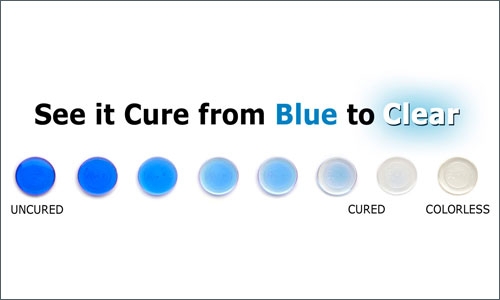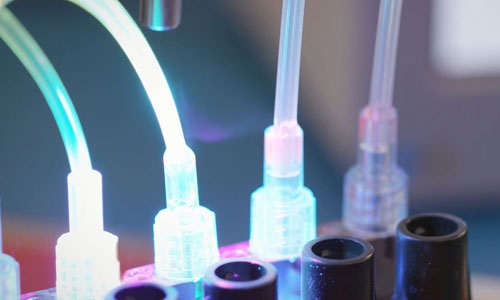Adhesive Outgassing
Q: I need a recommendation for a medical-grade non-cytotoxic UV adhesive for bonding together clear polystyrene moldings. What adhesive would you recommend? What is a simple but effective method to monitor if the curing reaction has gone to completion? Is there any dosimeter available to accurately measure the UV exposure? Would a post-bake after UV curing help? Does anything "outgas" from the UV medical-grade acrylates during curing?
A: Two options come to mind when looking for a medical-grade light-curable adhesive for polystyrene: Dymax 1201-M-SC and 1120-M-UR. These materials exhibit excellent adhesion to polystyrene and are both ISO 10993/USP Class VI tested.
One simple but effective method to monitor if the curing has gone to completion is incorporated into the 1201-M-SC product. This material uses a technology called See-Cure, where the material starts off with a brilliant blue color, and as it cures changes to colorless. This is an excellent visual indicator that a complete cure has been achieved in all parts of the bond line. Other methods to determine state of cure include destructive testing of the components to measure tensile force, or a drop of adhesive at the bond-line surface and using this droplet to measure for tack/semi-cure (a go/no-go measurement observed by the presence or absence of adhesive transfer onto a gloved finger). More complex methods include microscope FTIR analysis of the adhesive to identify the presence of the double-bond peak (on the spectrum) before cure, and the removal of the double-bond peak after cure.
Dosimeters are necessary to accurately measure light exposure, and there are different versions, with different sensors, that measure various parts of the UV and visible light spectrum. While most light-curable adhesives cure with a combination of UV-A, UV-B, UV-C, and visible light, it is often convenient to reference the UV-A light spectrum coming from the light source. UV-A is commonly referred to as 365 nm but covers a range of approximately 320-395 nm. This can be measured with an ACCU-CAL™ 50 radiometer. If the polystyrene is UV-blocking, then you would have to rely on the visible light spectrum of the lamp. The ACCU-CAL™ 50V measures 395-465 nm. Both units can give you average intensitRegarding2), peak intensity, and total energy (Joules/cm2). Other options are available like the ACCU-CAL™ 50 LED, which was developed for special lamps (such as LED lights which only emit a single wavelength at either 365 nm, 385 nm, or 405 nm) to integrate around the center of the lamp spectrum.
A post-bake is not necessary on most adhesives, but there are a few adhesives with a peroxide thermal initiator, which can use heat to cure areas not able to see light.
In regards to the question about outgassing of UV light-curable adhesives during cure, it is sometimes observed that a small amount of smoke comes up from the adhesive surface during the cure step. This is typical, as the adhesive may emit trace amounts of some of the ingredients (or fractions of the ingredients) contained in the formulation while light is shining on the adhesive and cure is taking place. Sometimes this can be overcome by varying the intensity and duration of cure, as well as adhesive choice and light source. This does not happen when the adhesive is used between two surfaces. Proper ventilation can help remove this smoke. If the smoke deposits onto a spot or flood lamp, then periodic cleaning of the end of the lightguide or lamp housing should be done to remove the film that may form there, as this thin film can reduce the intensity at the bond line.
_________________________________________________________
Enjoying This Content? Let’s Stay Connected.
If you’re finding value in our insights, why not get more of it—delivered right to your inbox? Subscribe to receive the latest technical articles, white papers, product news, and expert tips.


